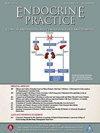The Challenge of Fractures in Patients With Chronic Kidney Disease
IF 3.7
3区 医学
Q2 ENDOCRINOLOGY & METABOLISM
引用次数: 0
Abstract
Objective
People with chronic kidney disease (CKD) are at increased risk of fractures in comparison to the non-CKD population, and fractures are associated with high mortality and worsening quality of life. However, the approach for evaluation of bone disease and fracture risk in CKD is different from the approach in the general population.
Methods
The authors conducted a literature review of PubMed to include studies on pathophysiology of CKD mineral bone disorder, fracture risk assessment, and therapeutic options in the setting of CKD.
Results
The higher risk observed in the CKD population is related to the complex interplay of changes in bone turnover (T), mineralization (M), and volume (V), along with other risk factors accumulated as glomerular filtration rate declines. The diagnosis of the type of renal osteodystrophy is not based only on assessment of bone density and traditional risk factors for osteoporosis. There are limitations of currently available fracture risk tools in the CKD population. Treatment choice should take into consideration the 3 components of the TMV classification along with the stage of kidney disease and comorbidities, but the assessment of these components has not been well established.
Conclusions
Current data are limited on efficacy and safety of treatments for fracture prevention in CKD. As new medications for the treatment of osteoporosis become available, there is an urgency to establish more clear guidelines for the diagnosis, fracture risk stratification, and treatment of bone disease in CKD.
慢性肾脏疾病患者骨折的挑战。
与非CKD人群相比,慢性肾脏疾病(CKD)患者骨折的风险增加,骨折与高死亡率和生活质量恶化有关。在CKD人群中观察到的较高风险与CKD-矿物质骨障碍(MBD)异常的复杂相互作用有关,这些异常导致骨转换(T)、矿化(M)和体积(V)的变化,以及肾小球滤过率下降时积累的其他危险因素。评估CKD患者骨病和骨折风险的方法与一般人群的方法不同。首先,肾性骨营养不良类型的诊断并不仅仅基于骨密度和骨质疏松的传统危险因素的评估。其次,目前CKD人群中可用的骨折风险工具可能存在局限性。第三,治疗选择应考虑TMV分类的三个组成部分以及肾脏疾病的分期和合并症,但这些组成部分的评估尚未很好地建立。最后,目前关于CKD预防骨折治疗的有效性和安全性的数据有限。随着治疗骨质疏松的新药物的出现,迫切需要建立更明确的CKD诊断、骨折风险分层和骨病治疗指南。在这篇综述中,我们讨论了CKD人群骨病管理的复杂性和争议,强调了未来需要研究的重点,同时为当前该人群的护理提供了临床考虑。
本文章由计算机程序翻译,如有差异,请以英文原文为准。
求助全文
约1分钟内获得全文
求助全文
来源期刊

Endocrine Practice
ENDOCRINOLOGY & METABOLISM-
CiteScore
7.60
自引率
2.40%
发文量
546
审稿时长
41 days
期刊介绍:
Endocrine Practice (ISSN: 1530-891X), a peer-reviewed journal published twelve times a year, is the official journal of the American Association of Clinical Endocrinologists (AACE). The primary mission of Endocrine Practice is to enhance the health care of patients with endocrine diseases through continuing education of practicing endocrinologists.
 求助内容:
求助内容: 应助结果提醒方式:
应助结果提醒方式:


